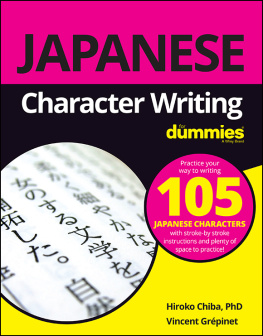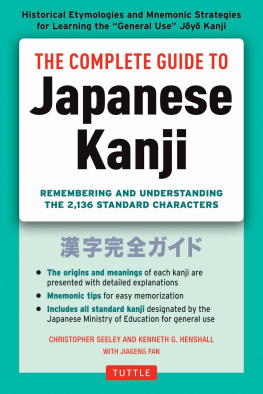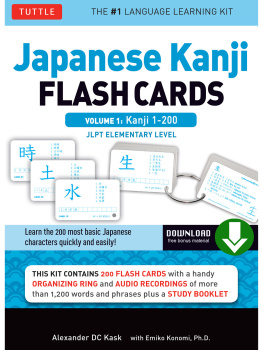

Japanese Character Writing For Dummies
Published by: John Wiley & Sons, Inc., 111 River Street, Hoboken, NJ 07030-5774, www.wiley.com
Copyright 2020 by John Wiley & Sons, Inc., Hoboken, New Jersey
Published simultaneously in Canada
No part of this publication may be reproduced, stored in a retrieval system or transmitted in any form or by any means, electronic, mechanical, photocopying, recording, scanning or otherwise, except as permitted under Sections 107 or 108 of the 1976 United States Copyright Act, without the prior written permission of the Publisher. Requests to the Publisher for permission should be addressed to the Permissions Department, John Wiley & Sons, Inc., 111 River Street, Hoboken, NJ 07030, (201) 748-6011, fax (201) 748-6008, or online at http://www.wiley.com/go/permissions .
Trademarks: Wiley, For Dummies, the Dummies Man logo, Dummies.com, Making Everything Easier, and related trade dress are trademarks or registered trademarks of John Wiley & Sons, Inc., and may not be used without written permission. All other trademarks are the property of their respective owners. John Wiley & Sons, Inc., is not associated with any product or vendor mentioned in this book.
LIMIT OF LIABILITY/DISCLAIMER OF WARRANTY: WHILE THE PUBLISHER AND AUTHOR HAVE USED THEIR BEST EFFORTS IN PREPARING THIS BOOK, THEY MAKE NO REPRESENTATIONS OR WARRANTIES WITH RESPECT TO THE ACCURACY OR COMPLETENESS OF THE CONTENTS OF THIS BOOK AND SPECIFICALLY DISCLAIM ANY IMPLIED WARRANTIES OF MERCHANTABILITY OR FITNESS FOR A PARTICULAR PURPOSE. NO WARRANTY MAY BE CREATED OR EXTENDED BY SALES REPRESENTATIVES OR WRITTEN SALES MATERIALS. THE ADVICE AND STRATEGIES CONTAINED HEREIN MAY NOT BE SUITABLE FOR YOUR SITUATION. YOU SHOULD CONSULT WITH A PROFESSIONAL WHERE APPROPRIATE. NEITHER THE PUBLISHER NOR THE AUTHOR SHALL BE LIABLE FOR DAMAGES ARISING HEREFROM.
For general information on our other products and services, please contact our Customer Care Department within the U.S. at 877-762-2974, outside the U.S. at 317-572-3993, or fax 317-572-4002. For technical support, please visit https://hub.wiley.com/community/support/dummies .
Wiley publishes in a variety of print and electronic formats and by print-on-demand. Some material included with standard print versions of this book may not be included in e-books or in print-on-demand. If this book refers to media such as a CD or DVD that is not included in the version you purchased, you may download this material at http://booksupport.wiley.com . For more information about Wiley products, visit www.wiley.com .
Library of Congress Control Number: 2019953292
ISBN 978-1-119-47543-9 (pbk); ISBN 978-1-119-47545-3 (ebk); ISBN 978-1-119-47534-7 (ebk)
Japanese Character Writing For Dummies
To view this book's Cheat Sheet, simply go to www.dummies.com and search for Japanese Character Writing For Dummies Cheat Sheet in the Search box.
Table of Contents
List of Tables
- Chapter 1
Guide
Pages
Introduction
Every language has its own journey and stories. This book introduces the stories of the Japanese language through the practice of kanji. More than 1,500 years ago, kanji came to Japan from China through Korea. Its a meaning-based script that is, each kanji represents a meaning. Kanji is not only an essential part of the Japanese language, but is also used as a medium for art such as calligraphy. Whatever your degree of interest in Japanese language and culture, you will feel the joy of setting foot in a new world by learning kanji. You may have heard that kanji is complicated and difficult to learn. Although it is true that one cannot master kanji overnight, you will find the learning process quite enjoyable.
About This Book
This book is intended for people who have absolutely no prior knowledge of kanji. However, it is also useful for those who have learned Japanese but want to polish their kanji.
In this book, you will learn 105 characters of Japanese kanji. Each kanji is introduced with a story related to the kanji along with examples of how its used. There will be plenty of spaces (which look like square boxes) for you to practice the target kanji. Remember to follow the stroke order (the order for drawing lines in each kanji). Once you get a general sense of how the lines are ordered, you can speed up your writing, which will make learning kanji faster and more efficient. Before you start browsing kanji introduced in this book, here is some helpful information to keep in mind:
- Hiragana annotations (ruby). Weve placed the hiragana annotations above most of the kanji used in the description, in case you already know hiragana. For example, the kanji for mountain will be displayed with hiragana above it, so the result will look like this:
- Selection of kanji. The choice of a hundred five basic kanji is very subjective. We selected the ones that we thought were the most useful for everyday living, for understanding leaflets, signs, menus, and so on.
- Readings (pronunciations) of kanji. For most kanji, there are two types of readings: onyomi and kunyomi readings. Onyomi is an appropriation of the original Chinese sound and kunyomi is often called Japanese reading, which indicates that the word is of Japanese origin. This system is explained in more detail in . Some of the kanji weve selected here have more readings, but weve presented the most common ones.
- Kanji compounds. Kanji may be used independently with grammatical endings in hiragana. You will also see multiple kanji characters in one word. In this book, we call these multiple-kanji words kanji compounds.
I also use a few conventions in this book to help your reading go smoothly:
- In many places throughout this book, Japanese terms appear in two forms: as Japanese scripts (like what you would read if you were in Japan) and as romanized forms of words (which appear in italics so you can easily find them in the text). The official term for romanized Japanese is rmaji (rohh-mah-jee). Although, in many cases, it is easy to figure out how to pronounce rmaji, when you are not sure of the pronunciation of a rmaji sound, refer to .
- Following each Japanese term, its meaning or English equivalent is provided within a pair of parentheses.
- Conventionally, in kanji dictionaries that are written for English speakers, the pronunciation of Chinese origin is printed in uppercase letters, but the words of Japanese origin are written in lowercase. We will follow that convention in this book.
Note: Grammar points are not covered in this book, but you can learn more about Japanese grammar in Japanese For Dummies!
Foolish Assumptions
This is an exercise book for writing Japanese kanji. We created this book assuming the following:
- You know a little Japanese, but you never had time to study kanji characters.
- You do not know anything about Japanese, but its written form fascinates you.
- You have already done some Japanese writing, but you have forgotten it and want to practice more.
Next page





![Eriko Sato - My First Japanese Kanji Book: Learning kanji the fun and easy way! [Downloadable MP3 Audio Included]](/uploads/posts/book/406403/thumbs/eriko-sato-my-first-japanese-kanji-book-learning.jpg)









